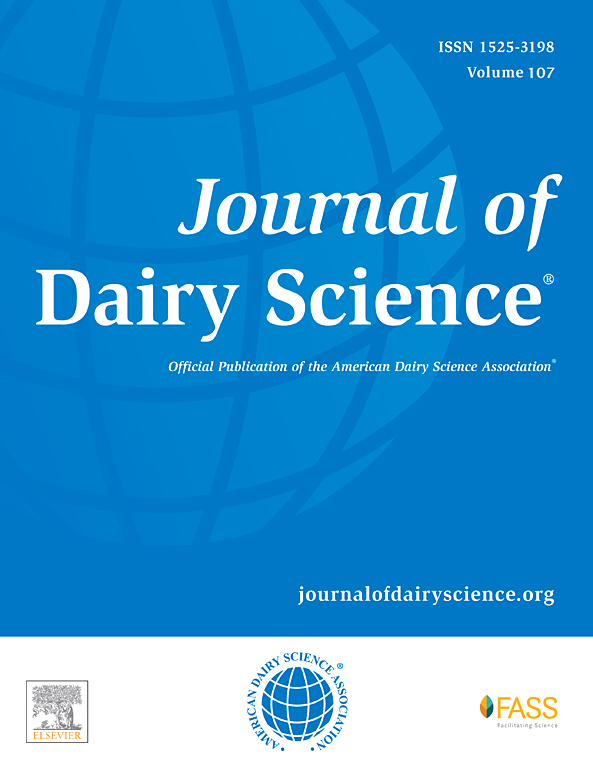Exploring the metabolic dynamics, storage stability, and functional potential of Lacticaseibacillus rhamnosus Probio-M9-fermented milk
IF 3.7
1区 农林科学
Q1 AGRICULTURE, DAIRY & ANIMAL SCIENCE
引用次数: 0
Abstract
Lacticaseibacillus rhamnosus Probio-M9 (Probio-M9), a probiotic strain sourced from healthy breast milk, is recognized for its resilience to gastric and bile acids, along with its potential health benefits for infants. Its unique origin may influence its metabolic properties and effectiveness, and it has garnered increasing interest within the scientific community in recent years. However, research on its efficacy as a starter culture for milk fermentation and the associated metabolic shifts remains limited. This study aimed to track the dynamic metabolomic changes of Probio-M9 during the fermentation process. We used Probio-M9 as the sole inoculant for milk fermentation, collecting samples at 1.5- to 3-h intervals to monitor fermentation progression. Moreover, the metabolomics changes of the fermented milk were investigated after a 28-d storage period to evaluate post-storage stability. Metabolite profiles were generated using ultra-high performance liquid chromatography coupled with quadrupole time-of-flight MS with multiple segment extraction. A total of 34 representative differential metabolites were identified, primarily comprising peptides and saccharides, followed by acids, amino acids, alcohols, aldehydes, ketones, and intermediate metabolites. Notably, substantial alterations in metabolite levels were observed between 10.5 and 12 h into the fermentation process. Functional metabolites like syringaldehyde, leucic acid, and gentianose accumulated toward the end of fermentation, whereas peptides emerged as the main differential metabolites after the 28-d storage period. The study offers novel insights into the metabolic dynamics of Probio-M9 during fermentation and storage, which may inform the optimization of Probio-M9-fermented milk production processes. However, it is important to note that the focus of this study on a single starter strain may limit the generalizability of these findings.
探索鼠李糖乳杆菌 Probio-M9 发酵乳的代谢动态、储存稳定性和功能潜力。
Lacticaseibacillus rhamnosus Probio-M9(Probio-M9)是从健康母乳中提取的益生菌株,因其对胃酸和胆汁酸的耐受性及其对婴儿健康的潜在益处而受到认可。其独特的来源可能会影响其代谢特性和功效,近年来引起了科学界越来越多的关注。然而,有关其作为牛奶发酵启动培养物的功效以及相关代谢变化的研究仍然有限。本研究旨在跟踪 Probio-M9 在发酵过程中的动态代谢组变化。我们利用 Probio-M9 作为牛奶发酵的唯一接种剂,每隔 1.5 至 3 小时采集一次样品,以监测发酵过程。此外,我们还研究了发酵牛奶在储存 28 天后的代谢组学变化,以评估储存后的稳定性。采用超高效液相色谱-四极杆飞行时间质谱法(UPLC-Q-TOF-MSE)生成了代谢物图谱。共鉴定出 34 种具有代表性的差异代谢物,主要包括肽和糖,其次是酸、氨基酸、醇、醛、酮和中间代谢物。值得注意的是,在发酵过程的 10.5 至 12 小时期间,代谢物水平发生了重大变化。丁香醛、亮氨酸和龙胆糖等功能性代谢物在发酵末期不断积累,而肽则在 28 天的储存期后成为主要的差异代谢物。这项研究为了解普罗布欧-M9 在发酵和贮藏期间的代谢动态提供了新的视角,可为优化普罗布欧-M9 发酵乳的生产工艺提供参考。不过,需要注意的是,这项研究的重点是单一的启动菌株,这可能会限制研究结果的推广性。
本文章由计算机程序翻译,如有差异,请以英文原文为准。
求助全文
约1分钟内获得全文
求助全文
来源期刊

Journal of Dairy Science
农林科学-奶制品与动物科学
CiteScore
7.90
自引率
17.10%
发文量
784
审稿时长
4.2 months
期刊介绍:
The official journal of the American Dairy Science Association®, Journal of Dairy Science® (JDS) is the leading peer-reviewed general dairy research journal in the world. JDS readers represent education, industry, and government agencies in more than 70 countries with interests in biochemistry, breeding, economics, engineering, environment, food science, genetics, microbiology, nutrition, pathology, physiology, processing, public health, quality assurance, and sanitation.
 求助内容:
求助内容: 应助结果提醒方式:
应助结果提醒方式:


